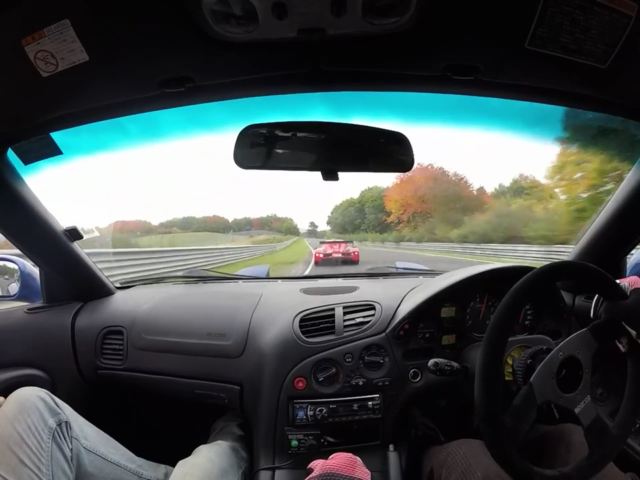While those who idolize the 13B rotary engine might feel physically ill at the sight of an American V8 swapped into their beloved RX-7, they only represent a contingent of RX-7 fans who are perhaps a little too romantic, and likely dwindling in size. The track rats of the world, who might be a little less swayed by heritage and more concerned with performance and reliability, cannot help but acknowledge the promise of an LS3 stuck neatly in the RX-7’s engine bay.
It’s a classic combination of a small, rear wheel-drive sports car with a thundering V8 of considerable size—6.3 liters in this case. The LS3 utilizes an aluminum block, pushes the scales at roughly 400 pounds, and does not offset the RX-7’s original weight distribution—plus it generates much less heat, and certain versions come with a dry-sump system installed. For the purposes of circuit driving, the list of charges against the rotary route is growing.
Obviously power and torque make it appealing as well; the Camaro-spec LS3 left the factory with ~424 horsepower and ~420 lb-ft of torque. With a Tremec TR6060 gearbox and a Cobra rear end, the power is easily harnessed. It’s a stellar package and it’s reliable, too.
Moreover, this particular build is made even more track-friendly with the addition of Stoptech big brakes up front, RS 314mm rear brakes, a Setrab power steering cooler, and a pair of Mazda oil coolers, and a rear-mounted Odyssey ER40 battery shifting weight towards the rear slightly. With this build, the weight distribution and handling balance are of utmost importance.
That balance is evident in how progressively this car breaks traction—even at high speed (7:35). So smooth, so responsive, so predictable, and yet when the road straightens, the E46 M3 ahead—no slouch by most standards—looks like its running on four cylinders. Even more impressive—the Radical doesn’t have much on the Mazda, if any (4:51).
Though the RX-7 is obviously in a class of its own in the above footage, its performance is comparable to this tuned GT-R, though they way the they corner is quite different.
https://
The GT-R is superb when asked to put down its power on a greasy, slightly damp Nordschleife; out of most slow-speed corners, the Nissan is superior. Additionally, when it gets a chance to stretch it legs and let its V6 bark, it looks to have a straight-line advantage. So, the way the Mazda can claw back ground in the tighter sections of the track needs to be seen to be believed.
Even being comparatively timid through traffic—respectful, you might say—the Mazda’s driver repeatedly closes the gap! It’s a matter of weight making the difference here, as the braking distances are vastly different, and through the technical, downhill section of the Nordschleife, as covered in the last couple minutes of the video, the GT-R’s weight starts limiting its effectiveness. Here’s the scalpel-sharp Mazda responds to the slightest tug of the wheel, and the nose dives neatly into the corner. That, coupled with a progressive, tractable, torquey motor, makes this a machine to be reckoned with. It would be one thing if this were a dedicated track car, but for my money, it looks like a mildly-tuned road car—hard to believe it’s nearly thirty years old!






















